An overgrown lawn can be quite a site to behold, and it can be quite intimidating to work on. You start to wonder where to begin, because the grasses are several times taller than they use to be.
Maybe you left your home for a vacation or maybe you just purchased a new property and you found the yard in a very sorry state. Perhaps you’ve just been very busy with other affairs and failed to take care of your own yard for some time and it grew into that state.
Whatever your reason is, the fact remains the same. There’s an overgrown yard in your hands and you have to fix it.
Of course, you can call in a yard care company to do the job, and they’ll get it done for the right price. On the other hand, you can get it done yourself if you have the time and the tools to get it done.
Cutting or mowing a well-kept lawn is one thing, fixing an overgrown one on the other hand, is a whole different story.
There’s a right way and a wrong way to do it. Do it the wrong way, you might actually end up damaging it further instead of fixing it.
That’s why I’ve written this article to help guide anyone who has found their selves in this situation. The following are the steps you should take to restore your overgrown lawn to it’s former pristine state.
Table of Contents
Consider the weather
Cutting your overgrown lawn is going to take some time and planning. Sometimes, it can take between 2 weeks to a month depending on how tall the grasses have been, and how large the yard is.

Since you cannot just hack everything down once, you need to consider the weather condition before moving forward with the cut. You don’t want to be interrupted by rain.
If it’s wet and rainy, you should consider holding on for a while until the weather is warm and sunny.
Generally, dry grass is easier to cut cleanly and evenly. Cutting grass when it’s wet can lead to uneven and ragged cuts, causing stress to the grass blades and making them more susceptible to disease and pests. This can result in a patchy and unhealthy lawn.
Wet grass also tends to clump together and can clog your mower’s cutting deck, especially if the grass is overgrown. This can lead to inefficient mowing, uneven cutting, and potential damage to your lawn mower.
It will also be more time-consuming as the mower may need to be stopped frequently to unclog clippings. On the other hand, cutting dry grass reduces the risk of clogs and ensures smoother operation of your mower machine.
Another reason why you want to consider the weather, and make sure you’re not mowing or cutting your lawn grasses when they’re wet is that it can be hazardous to you. Wet grass is slippery, which can increase the risk of you slipping and falling while walking on it. And this will also make it difficult for you to maintain control over the mower.
That means you need to check your weather forecast for the month and know the optimal time to proceed with the cut.
Inspect the lawn

If a lawn is overgrown, it usually means it has been abandoned without maintenance for some time. Hence, there’s a real chance that there are foreign materials inside the grass like stones, pieces of metal or wood that may not be visible right away. Who knows, some form of wildlife like snakes and rabbits might have even made it their home.
So, before trying to cut the grass, first inspect the lawn and take out any foreign material that might come in contact with your trimmer or mower blades.
Take a garbage bag and a trash grabber with you and walk through the lawn carefully inspecting it and pick up all the trash and foreign objects.
If there’s a patio area with grasses growing in between the cracks or spaces between the concrete, this is your opportunity to move all the patio furniture away towards a corner, so those grasses and weed can be removed when you start trimming.
Remove unwanted plants
Since the lawn is overgrown, there’re surely going to be unwanted woody plants and weeds growing in it. Try to remove these woody plants either by using a brush cutter since a simple string trimmer might not be powerful enough to get a them.
Once this is done, it’s time for your first cut.
Pick the right equipment
If you have an overgrown lawn to deal with, the first equipment you need to make the first cut is not a lawnmower.
Starting with a mower can actually damage the lawn mower because the grass is very long and can tangle with the blades, preventing it from spinning and subsequently causing the engine or motor to overheat.
What you need is a string trimmer or a brush cutter.
Make the first cut
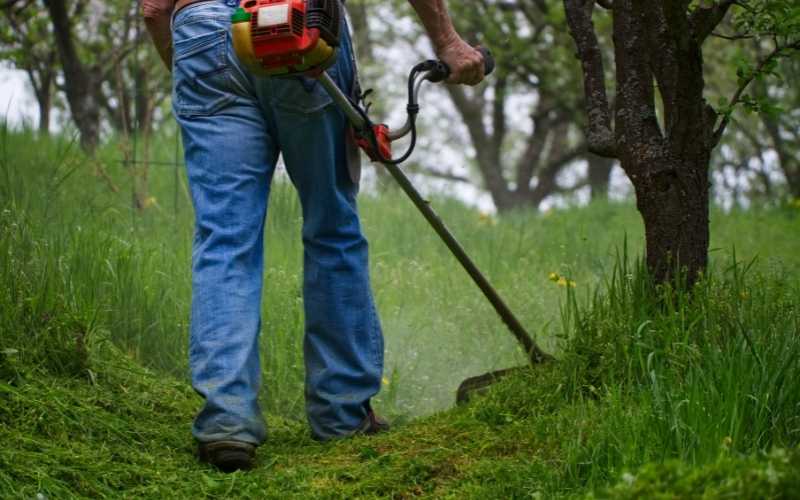
Making the first cut is pretty straightforward. Like I said earlier, you just can’t hack everything down at once, unless you don’t really care about the end result.
First, you need to use a string trimmer to trim the current height of the grass by 50 percent. If the grass is full of hard weeds and shrubs, then try using a brush cutter instead. After this trim, allow a few days (2 to 4 days) to pass before making the next cut.
Cutting only 50 percent of the current height of the grass and allowing a few days to pass before the next cut prevents it from going into shock and withering off.
If you cut all of the grass at once, it responds by growing faster than usual in an attempt to recover, and uses up all the food stored in the roots.
Since the root is no longer supplying nutrients, the exposed crowns gets burned by the sun and withers or dies off.
Related: Definitive Guide To Lawn Striping
Rake up the grass trimmings

After the first trim, there’ll surely be lots of grass trimmings left on top of the lawn. This should be raked off and bagged as soon as possible to allow the lawn recover properly.
Leaving the grass clippings on it can smother the grass and inhibit its growth. So, try to rake off the grass clippings as soon as possible, or use a leaf blower if possible.
Make a second cut
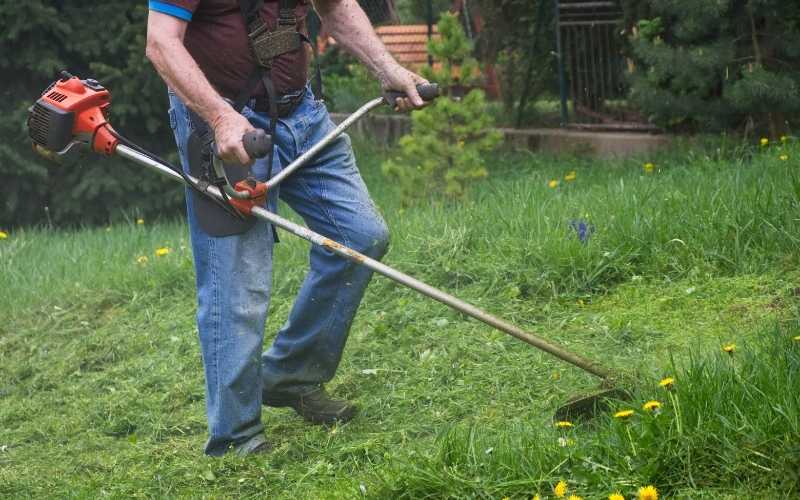
A few days have passed, now you’re ready for the second cut still using a string trimmer or a brush cutter. At this stage, the grass has fully recovered and you can safely cut and reduce the height of the grass to 6 or 7 inches tall.
After that, allow the lawn to rest and recover again for a few days.
Use a mower to level
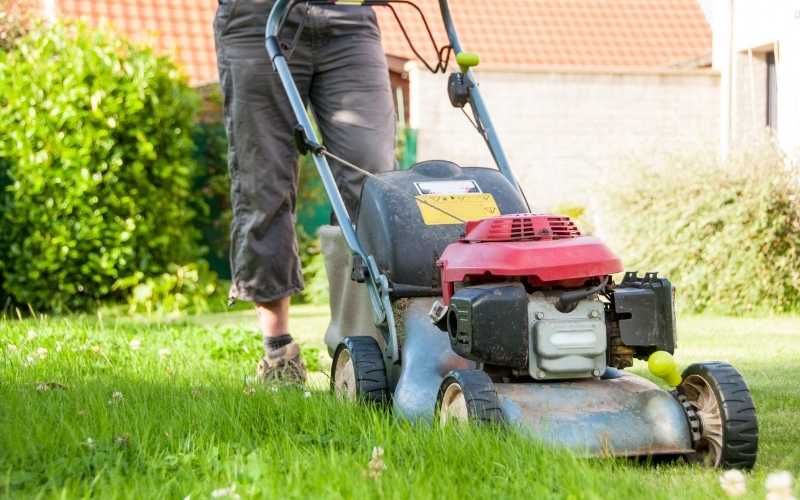
You’ve been holding back from using your lawnmower for 8 to 10 days. Now, it’s time to bring it out and level the grass.
Obviously, a string trimmer or brush cutter won’t produce the most level lawn. Using a mower at this stage can help level the grass properly, provided you create an overlap of several inches to blend one pass with the next.
Try to remove about 1/3 of the grass remaining and as usual, allow it to recover for about 4 days or more, then repeat.
Trim the edges

Even though the grass has been properly cut down, the task is not complete if the lawn is not edged properly.
Edging helps define the boundaries of your lawn, making the overall work neater, and ultimately increasing your homes curb appeal.
So, when you done mowing the lawn to your preferred height, it’s important to pick up a landscape edger if you have one and trim the edges neatly.
If you don’t have a landscape edger, you can also use a brush cutter or string trimmer to cut the edges neatly. This will improve the overall appearance of your yard, and make your work neater.
Continue maintenance to prevent future overgrowth
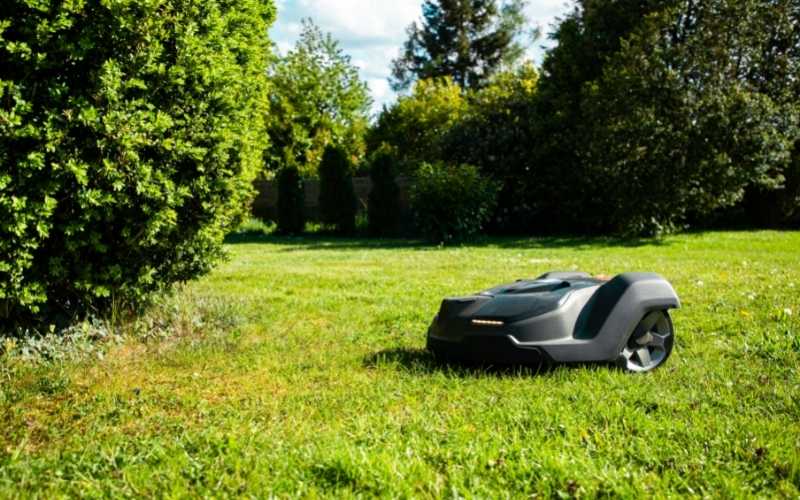
Now that the lawn is in good shape, you don’t want it going back to the way it was before. That’s where regular maintenance comes in. It needs to be mowed at least every 2 weeks to keep it in good condition, especially during the growing season.
Setting aside time to do this cannot be the same for everybody. For some it’s easy, while to others it’s quite difficult.
If you have the means, you can always hire a local lawn care company to do the job for you. On the other hand, you can mow it by yourself every two weeks if you have the time.
Furthermore, there’s a third option which does not require you to hire someone else to do it, and does not require you to mow it yourself. It’s by using a robotic lawn mower.
A robotic lawn mower can be programmed to mow your lawn at specific times and days of the week. It can be set to mow during the day or during the night depending on how you use your yard.
You can just set it and leave it, and it will keep mowing your lawn. Even if you travel or go on a vacation, you can be rest assured, your lawn will not turn out overgrown when you get back from your vacation.
Reseed and water bald patches
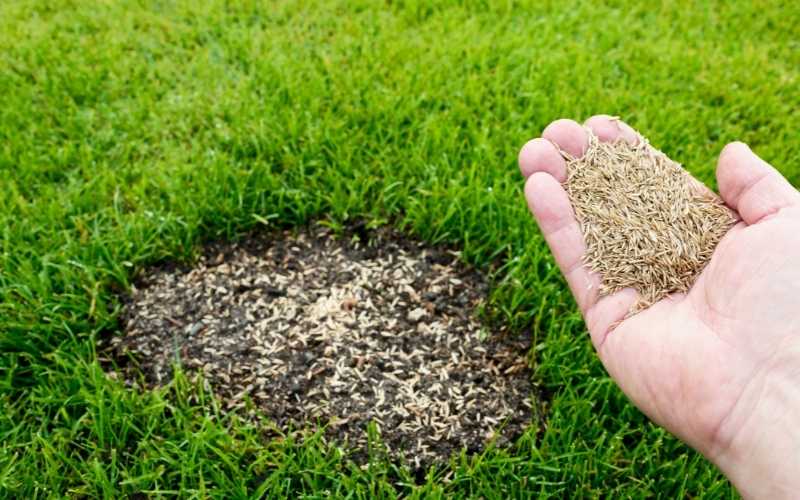
After successfully mowing or cutting your overgrown lawn, you might find some bald patches with no grasses in them.
This is prone to occur with overgrown lawns, because tall grasses block out the sun from reaching the bottom of the lawn and thus inhibits the growth of new grasses.
To correct this, you can simply reseed these areas and water generously so grasses can start growing in those areas again.
Remember to continue watering daily to help these new seeds germinate and grow properly.

